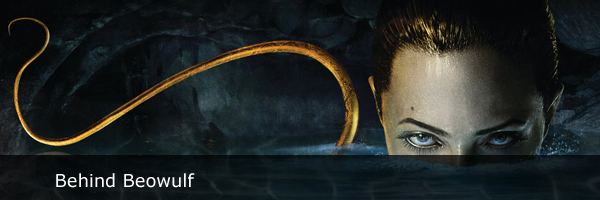THE BACKLOT

By William Kallay
Despite my own reservations in watching "Beowulf,"
I hope I'm big enough to admit that the visual effects in the film are
tremendous and dazzling. I admit, right here and now, that the film is
downright cool to look at. The film took an amazing amount of energy and
artistry to bring to the big screen, and while at WonderCon 2008 in San
Francisco, I attended a panel of some of the visual effects artists.
Kenn McDonald, Corey Turner, Theo Vandernoot, and Francis Liu took the
audience behind the scenes on how Grendel and the Golden Dragon were
brought to life.
"Beowulf" is actually a hybrid of various animation and visual effects
techniques. I won't pretend to know how all of these techniques are
combined to create the visual effects. All I know is that they go well
beyond the effects I loved so much in films like "Dragonslayer" (1981),
an underrated movie that reinvented my idea of dragons. "Beowulf" has
itself reinvented the dragon for the 21st century, as well as my own
interpretation of the hideous beast in Grendel. The visual effects team
at WonderCon showed some behind-the-scenes action on how they created
the Golden Dragon and Grendel. Some of this is available on the new
DVD/Blu-ray.
Let's start off with Grendel. In my opinion, he's the most dynamic and
interesting creature in the film. Downright frightening and monstrous,
Grendel actually gains my sympathy. He does destroy a lot of the Mead
Hall, expensive furniture, and kills a few warriors and lasses. But give
the poor monster a break. He's not the most handsome fellow at the ball,
nor can he communicate well. Nobody likes him, except for his Mother. So
what if his playtime consists of raiding the local village? In all
seriousness, Grendel is well-executed in the film, and to my eyes, the
use of motion capture, and later digital enhancement/animation, makes
his character come alive. I loved how Grendel enters the Mead Hall and
tosses warriors around like rag dolls.
Crispin Glover plays Grendel, and gives the character his childlike
behavior. As the panelists at WonderCon mentioned, Grendel has the mind
of an eight year-old. Perhaps not the perfect ideal of an eight
year-old. I wouldn't want my kid going around damaging people and
property. But their vision of Grendel fits well. Glover wore a special
body suit marked with sensors. The rest of the "Beowulf" cast did, too.
Special lighting and cameras captured those sensors and their positions
to create digital versions of the cast. As I describe this, I'm in no
way covering all the bases of how Grendel was completely rendered.
Motion capture and digital enhancement/animation is very detailed. I
think sometimes it's best to look beyond the technology and enjoy the
film. Grendel was then enhanced with skin texture, lighting, and
numerous "plussing" to get his hideous form to come alive. The result is
a beast that scares and still manages to have you feel for his pain.
The Golden Dragon is another feat of visual effects creativity. The
visual effects panel mentioned that they had looked at "Dragonslayer" as
one of their references. That creature was a tour de force in stop
motion animation. It flew, breathed fire, and crawled on its dragon
knuckles and still looks impressive today. The Golden Dragon in
"Beowulf" is combination of Ray Winstone's motion capture performance
and digital compositing (to name a few of the elements involved in
making the dragon). This dragon can swoop in every direction that
director Zemeckis wants, go underwater, and crash through mountain rock.
He's a Harryhausen protégé if there ever was one. The visual effects
team also made sure that the Golden Dragon had traits that the audience,
at first, might not notice. The creature was given internal anatomy
functions. Where does his fire come from? There are tubes in his throat
from his lungs which are made specifically shoot out fire. This,
interestingly enough, causes the dragon extreme pain. In the movie,
you'll notice at one point that the dragon is running out of fire and
seems fatigued.
The visual effects team did more work on the staging end of the film.
They would create at least 20 takes from different angles for director
Robert Zemeckis to move his own camera any way he wants. The shooting
ratio was usually 20 to 1. To embellish the fast camera moves in various
scenes, Zemeckis was given an old Sony Betacam to move around the
virtual scenes anyway he wanted to. This use of old school Sony
camcorders was also used in "Surf's Up."
"Beowulf" is every bit a "fan boy's" fantasy film. It's got the
hyper-violence, strange and wondrous creatures, dazzling visual effects,
and aggressive music by Alan Silvestri. The visual effects team should
be applauded for their efforts in bringing the legend alive. Grendel and
the Golden Dragon expect audiences to applaud their digital magic, or
else there's going to be some tossing and fire breathing mayhem.
Special thanks to Mac McLean and Deborah Peters
Photos © 2008 Paramount. All rights reserved.
Originally posted here on March 1, 2008